NVIDIA nForce 500: Biostar and MSI Aim for the Gold
by Gary Key on June 8, 2006 4:30 AM EST- Posted in
- Motherboards
Synthetic Graphics Performance
The 3DMark series of benchmarks developed and provided by Futuremark are among the most widely used tools for benchmark reporting and comparisons. Although the benchmarks are very useful for providing apple to apple comparisons across a broad array of GPU and CPU configurations they are not a substitute for actual application and gaming benchmarks. In this sense we consider the 3DMark benchmarks to be purely synthetic in nature but still valuable for providing consistent measurements of performance.
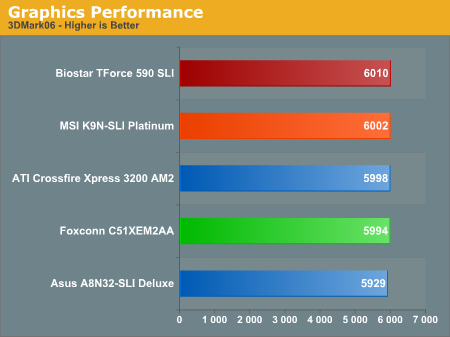
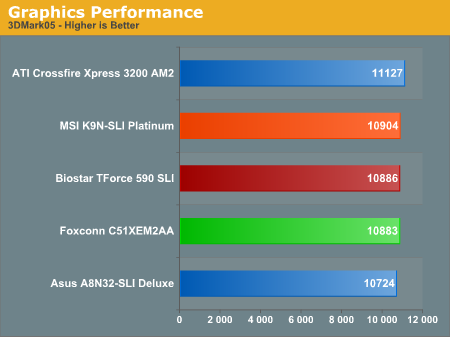
In our first tests, the Biostar and MSI boards lead the NVIDIA based systems by a small margin in each benchmark. However, the results are so close that it would be extremely difficult to determine a winner.
General System Performance
The PCMark05 benchmark developed and provided by Futuremark was designed for determining overall system performance for the typical home computing user. This tool provides both system and component level benchmarking results utilizing subsets of real world applications or programs. This benchmark is useful for providing comparative results across a broad array of Graphics subsystems, CPU, Hard Disk, and Memory configurations along with multithreading results. In this sense we consider the PCMark benchmark to be both synthetic and real world in nature while providing consistency in our benchmark results.
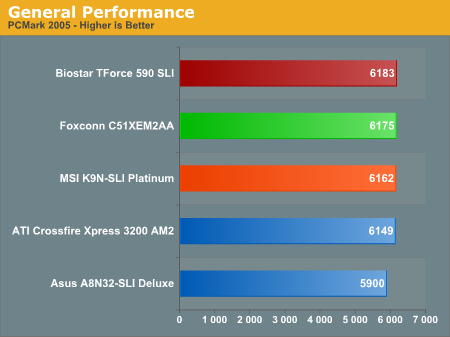
The margins are closer in the PCMark05 results but the Biostar board continues to show an advantage over the other NVIDIA based boards. Although these results are grouped tightly, this benchmark will show differences between platforms and provides an overview into how well each board will handle general office and video/audio applications along with simple multitasking of these program tests.
Rendering Performance
We have added the Cinebench 9.5 and POV-RAY 3.6 benchmarks as they heavily stress the CPU subsystem while performing graphics modeling and rendering. We utilize the standard benchmark demos in each program along with the default settings. Cinebench 9.5 features two different benchmarks with one test utilizing a single core and the second test showcasing the power of multiple cores in rendering the benchmark image.
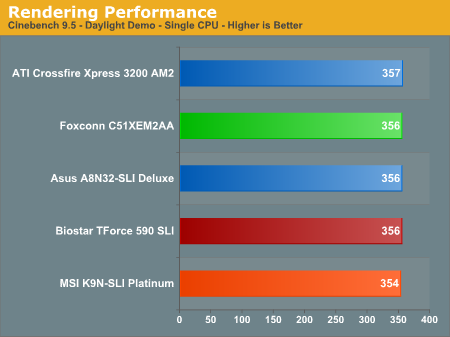
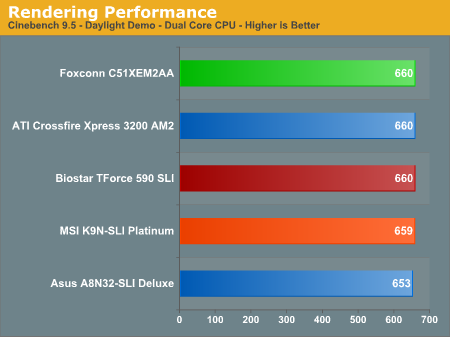
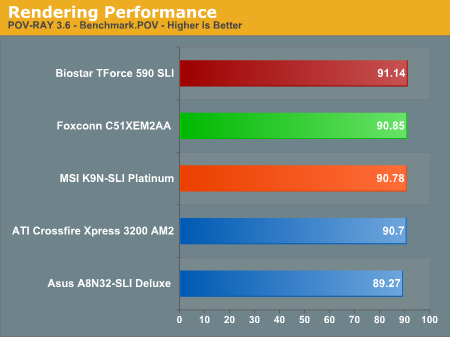
The Biostar board continues to make a strong showing in these benchmarks although all of the boards are tightly clustered in the scores. The Dual-Core Cinebench and POV-Ray results show the nForce 500 leading the nForce4 chipset by a measurable amount most likely due to the benefits of the increased DDR2 memory bandwidth.
The 3DMark series of benchmarks developed and provided by Futuremark are among the most widely used tools for benchmark reporting and comparisons. Although the benchmarks are very useful for providing apple to apple comparisons across a broad array of GPU and CPU configurations they are not a substitute for actual application and gaming benchmarks. In this sense we consider the 3DMark benchmarks to be purely synthetic in nature but still valuable for providing consistent measurements of performance.


In our first tests, the Biostar and MSI boards lead the NVIDIA based systems by a small margin in each benchmark. However, the results are so close that it would be extremely difficult to determine a winner.
General System Performance
The PCMark05 benchmark developed and provided by Futuremark was designed for determining overall system performance for the typical home computing user. This tool provides both system and component level benchmarking results utilizing subsets of real world applications or programs. This benchmark is useful for providing comparative results across a broad array of Graphics subsystems, CPU, Hard Disk, and Memory configurations along with multithreading results. In this sense we consider the PCMark benchmark to be both synthetic and real world in nature while providing consistency in our benchmark results.

The margins are closer in the PCMark05 results but the Biostar board continues to show an advantage over the other NVIDIA based boards. Although these results are grouped tightly, this benchmark will show differences between platforms and provides an overview into how well each board will handle general office and video/audio applications along with simple multitasking of these program tests.
Rendering Performance
We have added the Cinebench 9.5 and POV-RAY 3.6 benchmarks as they heavily stress the CPU subsystem while performing graphics modeling and rendering. We utilize the standard benchmark demos in each program along with the default settings. Cinebench 9.5 features two different benchmarks with one test utilizing a single core and the second test showcasing the power of multiple cores in rendering the benchmark image.



The Biostar board continues to make a strong showing in these benchmarks although all of the boards are tightly clustered in the scores. The Dual-Core Cinebench and POV-Ray results show the nForce 500 leading the nForce4 chipset by a measurable amount most likely due to the benefits of the increased DDR2 memory bandwidth.










17 Comments
View All Comments
dougcook - Friday, September 8, 2006 - link
I bought one of the MSI 570 boards (after reading this review). Everything seemed ok (some things seemed a bit cheap, but nothing really unusual). I got it all installed and running...For one day.
While burning a few CDs, the Northbridge overheated and the machine turned itself off. This happened 2 more times, and then the machine failed to boot at all (even after giving it time to cool off). I wasn't overclocking, and the box had decent ventilation.
This may not happen for everybody, but looking on NewEgg, it seems that this has happened to many other people. The MSI northbridge does not have an adequate heatsink and is likely to burn up. Save the time and get something better. I got the equivalent ABit 570 motherboard, and I've been very happy so far. I hear good things about the ASUS 570 as well.
MacGuffin - Wednesday, June 21, 2006 - link
I don't mean to be a whiny biyatch but where's the follow-up article? Are you guys playing around with Conroe motherboards and ES chips again?;-)JakeBlade - Friday, June 9, 2006 - link
Northbridge fans blow. No pun intended.Visual - Friday, June 9, 2006 - link
in the comparison table on page 2, you have incorectly listed a firewire, 6 usb ports and 2 esata ports for the MSI. it doesn't have those, just 4 usbs. it does have a COM and LPT ports that you need to list though.Gary Key - Friday, June 9, 2006 - link
The right table was inserted this time, thanks!!!! :)A554SS1N - Friday, June 9, 2006 - link
I'm interested in the MSI K9N 550 chipset, but noticed this 570 SLi chipset has the same sized passive cooler; could you tell me what the temperatures for the chipet on load are? (Sometimes SpeedFan might be needed to detect them on some boards?).Gary Key - Friday, June 9, 2006 - link
I will see if we can get an accurate internal chipset temperature for you. The heatsink itself was at 56c under load when measured with a infrared device.A554SS1N - Thursday, June 15, 2006 - link
Thanks, I could get an idea that it may be upto 70C internal from that external heatsink reading.R3MF - Thursday, June 8, 2006 - link
sorry, not buying.give me the 8x/16x SLI split, as well as 8x slot, two 1x slots, and a couple of PCI slots that i can ignore.
then i'll buy.
segagenesis - Thursday, June 8, 2006 - link
... is its AMD. After reading about Conroe I would hope nVidia does this for the Intel camp now that I'd rather buy one of those than AM2.